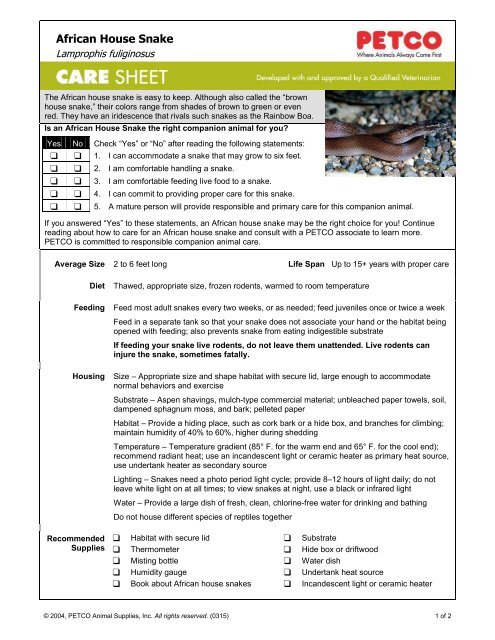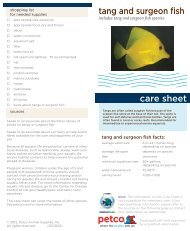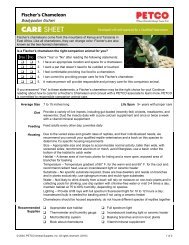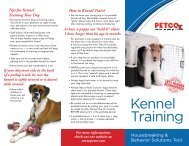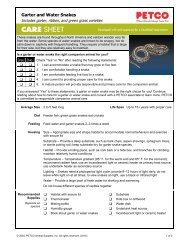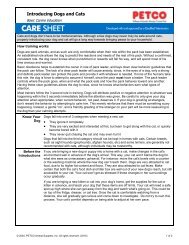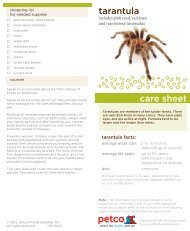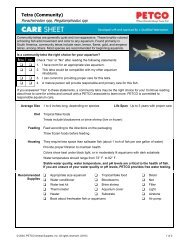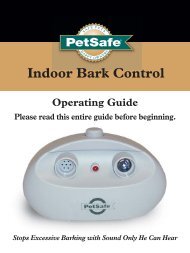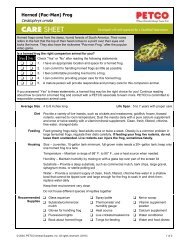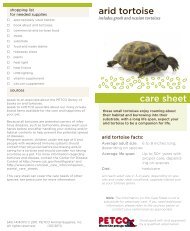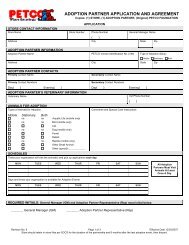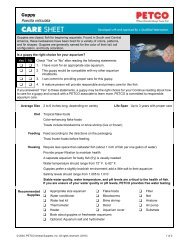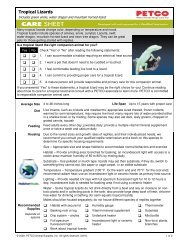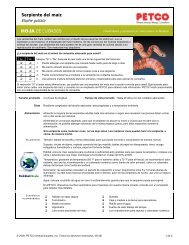You also want an ePaper? Increase the reach of your titles
YUMPU automatically turns print PDFs into web optimized ePapers that Google loves.
<strong>African</strong> <strong>House</strong> <strong>Snake</strong><br />
Lamprophis fuliginosus<br />
The <strong>African</strong> house snake is easy to keep. Although also called the “brown<br />
house snake,” their colors range from shades of brown to green or even<br />
red. They have an iridescence that rivals such snakes as the Rainbow Boa.<br />
Is an <strong>African</strong> <strong>House</strong> <strong>Snake</strong> the right companion animal for you?<br />
Yes No Check “Yes” or “No” after reading the following statements:<br />
❑ ❑ 1. I can accommodate a snake that may grow to six feet.<br />
❑ ❑ 2. I am comfortable handling a snake.<br />
❑ ❑ 3. I am comfortable feeding live food to a snake.<br />
❑ ❑ 4. I can commit to providing proper care for this snake.<br />
❑ ❑ 5. A mature person will provide responsible and primary care for this companion animal.<br />
If you answered “Yes” to these statements, an <strong>African</strong> house snake may be the right choice for you! Continue<br />
reading about how to care for an <strong>African</strong> house snake and consult with a PETCO associate to learn more.<br />
PETCO is committed to responsible companion animal care.<br />
Average Size 2 to 6 feet long Life Span Up to 15+ years with proper care<br />
Diet<br />
Feeding<br />
Thawed, appropriate size, frozen rodents, warmed to room temperature<br />
Feed most adult snakes every two weeks, or as needed; feed juveniles once or twice a week<br />
Feed in a separate tank so that your snake does not associate your hand or the habitat being<br />
opened with feeding; also prevents snake from eating indigestible substrate<br />
If feeding your snake live rodents, do not leave them unattended. Live rodents can<br />
injure the snake, sometimes fatally.<br />
Housing<br />
Size – Appropriate size and shape habitat with secure lid, large enough to accommodate<br />
normal behaviors and exercise<br />
Substrate – Aspen shavings, mulch-type commercial material; unbleached paper towels, soil,<br />
dampened sphagnum moss, and bark; pelleted paper<br />
Habitat – Provide a hiding place, such as cork bark or a hide box, and branches for climbing;<br />
maintain humidity of 40% to 60%, higher during shedding<br />
Temperature – Temperature gradient (85° F. for the warm end and 65° F. for the cool end);<br />
recommend radiant heat; use an incandescent light or ceramic heater as primary heat source,<br />
use undertank heater as secondary source<br />
Lighting – <strong>Snake</strong>s need a photo period light cycle; provide 8–12 hours of light daily; do not<br />
leave white light on at all times; to view snakes at night, use a black or infrared light<br />
Water – Provide a large dish of fresh, clean, chlorine-free water for drinking and bathing<br />
Do not house different species of reptiles together<br />
Recommended<br />
Supplies<br />
❑ Habitat with secure lid ❑ Substrate<br />
❑ Thermometer ❑ Hide box or driftwood<br />
❑ Misting bottle ❑ Water dish<br />
❑ Humidity gauge ❑ Undertank heat source<br />
❑ Book about <strong>African</strong> house snakes ❑ Incandescent light or ceramic heater<br />
© 2004, PETCO Animal Supplies, Inc. All rights reserved. (0315) 1 of 2
<strong>African</strong> <strong>House</strong> <strong>Snake</strong><br />
Lamprophis fuliginosus<br />
Normal<br />
Behavior and<br />
Interaction<br />
<strong>African</strong> house snakes are nocturnal; appetite may diminish during winter months<br />
As snake gets ready to shed, eyes will turn a milky blue over the course of a few days and<br />
body color will start to dull and develop a whitish sheen<br />
Can become tame, but be careful of their long teeth<br />
Habitat<br />
Maintenance<br />
Grooming<br />
and Hygiene<br />
Change water daily<br />
Thoroughly clean the tank at least once week: set snake aside in a secure habitat; scrub the<br />
tank and furnishings with a 3% bleach solution; rinse thoroughly with water, removing all smell<br />
of bleach; dry the tank and furnishings; and add clean substrate<br />
<strong>African</strong> house snakes will regularly shed their skin; ensure humidity of habitat is at appropriate<br />
level to allow snake to shed properly<br />
Always wash your hands before and after touching your snake or habitat contents to help<br />
prevent Salmonella and other infectious diseases<br />
To facilitate shedding, provide a large container that allows snake to immerse entire body<br />
Signs of a<br />
Healthy Animal<br />
Common<br />
Health Issues<br />
Clear eyes (except when shedding) Active and alert<br />
Clear nose and mouth Eats regularly<br />
Body is rounded and full Healthy skin<br />
Health Issue (alpha) Symptoms or Causes Suggested Action<br />
Dermatitis<br />
Stomatitis<br />
Respiratory Disease<br />
Ticks and Mites<br />
Blisters. Rapid shedding caused by<br />
an unclean habitat or one that is too<br />
cold or damp.<br />
White, cheesy substance in the<br />
mouth; loss of teeth and appetite<br />
Labored breathing. Mucus in mouth<br />
or nostrils. Can be caused by a<br />
habitat that is too cold or damp.<br />
Parasites on skin, can cause<br />
disease.<br />
Clean the habitat and lower<br />
humidity. Consult your exotic<br />
animal veterinarian.<br />
If untreated, can be fatal.<br />
Consult your exotic animal<br />
veterinarian.<br />
Keep snake warm and dry.<br />
Consult your exotic animal<br />
veterinarian.<br />
Consult your exotic animal<br />
veterinarian.<br />
Red Flags<br />
Sources<br />
Wrinkled or rubbed skin Vomiting<br />
Discharge in nose or mouth Lethargy<br />
Abnormal feces or urine Decreased appetite<br />
If you notice any of these signs, please contact your exotic animal veterinarian.<br />
Keeping and Breeding <strong>Snake</strong>s by Chris Mattison<br />
Perfect Pets: <strong>Snake</strong>s by Susan Schafer<br />
The Proper Care of <strong>Snake</strong>s by Armin Geus<br />
Note: The information on this Care Sheet is not a substitute for veterinary care. If you need additional<br />
information, please refer to the above sources or contact your veterinarian as appropriate.<br />
2 of 2 SKU 942740 © 2004, PETCO Animal Supplies, Inc. All rights reserved. (0315)


